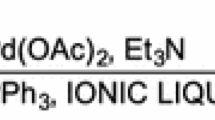Abstract
A microwave-assisted method is described for monoacylating 7-amino-5-aryl-6-cyanopyrido[2,3-d]pyrimidines using excess acid chlorides in pyridine. A diacylated intermediate is effectively deacylated to the product amide by a macroporous-Tris resin. A small library of 17 amides was prepared to validate the method. The integration of commercial microwave technology into the ArQule chemistry platform is also discussed.
Similar content being viewed by others
References
Ahmed, R. A., Kandeel, M. M., Abbady, M. S. and Youssef, M. S. K., Synthesis and reactions of 2-amino-6-(3-methyl-5-oxo-1-phenyl-2-pyrazolin-4-yl)-4-phenylpyridine-3-carbonitrile, J. Heterocycl. Chem., 39 (2002) 309–314.
Seada, M., El-Behairy, M. A., Jahine, H., and Hanafy, F., Reactions with 2-amino-3,5-dicyanopyridines, Orient. J. of Chem., 5 (1989) 273–80.
Hagen, V., Klauschenz, E., Rumler, A., Niedrich, H., Hagen, A., Heer, S., and Mitzner, R., Potential cardiotonic agents Part 8: 2-acyloxyalkylamino-, 2-acyloxyaklyloxy-, and 2-acylaminoalkylamino-3-cyano-5-(4-pyridinyl)pyridines, Pharmazie, 45 (1990) 343–345.
Kocevar, M., Koller, J., Stanovnik, B. and Tišler, M., Synthesis and transformations of some pyrido[2,3-d]pyrimidines, Monatsh. Chem., 118 (1987) 399–407.
Metwally, M. A., Fadda, A. A., Hassan, H. M. and Afsah, E., Synthesis of some 2-pyrazolin-5-one derivatives structurally related to certain analgesis and antipyretic drugs, Org. Prep. Proc. Int., 17 (1985) 198–203.
Nicewonger, R. B., Ditto, L. B., Kerr, D. and Varady, L., Synthesis of a novel, recyclable, solid-phase acylating reagent, Bioorg. Med. Chem. Lett., 12 (2002) 1799–1802.
Sutherland, I. O., Comprehensive Organic Chemistry Volume 2, Pergamon Press Ltd, Oxford, 1979, 159–161.
Ayyangar, N. R. and Srinivasan, K. V., Effect of substituents in the formation of diacetanilides, Can. J. Chem., 62 (1984) 1292–1296.
Tanaka, K., Shimazaki, M. and Murakami, Y., Synthesis of N-acetylbenzimidazole derivatives, Chem. Pharm. Bull., 30 (1982) 2714–2722.
Ishii, H., Sugiura, T., Akiyama, Y., Ichikawa, Y., Watanabe, T. and Murakami, Y., Fischer indolization and its related compounds. XXIII. Fischer indolization of ethyl pyruvate 2-(2,6-dimethoxyphenyl)phenylhydrazone, Chem. Pharm. Bull., 38 (1990) 2118–2126.
Murakami, Y., Watanabe, T., Hagiwara, T., Akiyama, Y., and Ishii, H., Fischer indolization and its related compounds. XXVI. Fischer indolization of ethyl pyruvate 2-[2-(trifluoromethyl)phenyl]-phenylhydrazone and new insight into the mechanism of the Goldberg reaction, Chem. Pharm. Bull., 43 (1995) 1281–1286.
Murakami, Y., Kondo, K., Miki, K., Akiyama, Y., Watanabe, T. and Yokoyama, Y., The ortho-substituted N,Ndiacetylaniline as a selective acylating reagent, Tetrahedron Lett., 38 (1997) 3751–3754.
To a solution of amine (150 µmol) in pyridine (600 µL) in a Personal Chemistry process vial (2–5 mL) was added a solution of acid chloride (1350 µmol) in pyridine (1800 µL). The process vial was crimped and irradiated in Personal Chemistry Smith Synthesizer at 230 C for 400 seconds at a normal absorption level. After cooling to room temperature, the reaction mixture was transferred from the microwave process vial into a 2-dram vial containing 400 mg of a macroporous Trisamine resin (ArgoPore-Trisamine from Argonaut Technologies, 2.51 mmol g-1). Acetonitrile (1000 µL) was then added to the 2-dram vial, and the resulting mixture was shaken for two hours at room temperature. Filtration, followed by solvent evaporation yielded the product monoamide, which was purified by reverse-phase HPLC.
Purification was done by RP-HPLC with MS trigger using a gradient of water (solvent A) and acetonitrile (solvent B) with 0.1% formic acid. Molecular weights were detected using positive electrospray ionization mode on the mass spectrometer with a cone voltage of 20 volts. These general conditions were applied across the set and not optimized for individual compounds.
The ArQule AMAPTM parallel synthesis platform employs a modular, unit operation approach similar to that in typical chemical engineering disciplines. The basic building block to this approach is an aluminum 24 or 96 well reaction block containing glass vials as reaction vessels. The modular workstations that represent the unit operations of synthetic organic chemistry such as reagent preparation, reagent dispensation, liquid-liquid extraction, conventional heating and shaking have been designed to accommodate either customized reaction block. Under this modular approach, operations are strung together in specific sequences to produce desired processes and conditions. An underlying information system drives the workstations and ties these operations together.
Author information
Authors and Affiliations
Corresponding author
Rights and permissions
About this article
Cite this article
Nicewonger, R., Fowke, A., Nguyen, K. et al. Microwave-assisted acylation of 7-amino-5-aryl-6-cyanopyrido[2,3-d]pyrimidines. Mol Divers 7, 247–252 (2003). https://doi.org/10.1023/B:MODI.0000006907.21070.11
Issue Date:
DOI: https://doi.org/10.1023/B:MODI.0000006907.21070.11




